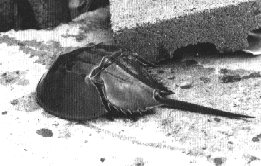
WEB MAIL BEACH
WEATHER HOTELS/MOTELS REAL ESTATE
VACATION
RENTALS RESTAURANTS
DINING OUR TOWNS FISHING - BOATING
CHARTER BOATS SHOPPING NIGHTLIFE THE OCEAN THE BAY
HORSESHOE CRABS
|

|
|
Photo: University of Delaware www.ocean.udel.edu |
Horseshoe crabs, common along the Delaware coast, have evolved little in the last 250 million years. Still, they have survived because of their hard, curved shells, which have made it difficult for predators to overturn them and expose their soft, vulnerable underbellies. The horseshoe crab has also survived because it can go a year without eating and endure extreme temperatures and salinity.
The Delaware Bay region is home to the largest population of the American horseshoe crab (Limulus polyphemus), which is found along the western shores of the Atlantic Ocean from Maine to the Yucatan. Another three species live in the coastal waters from Japan to Indonesia.
Once called "Horsefoot Crabs" because of the resemblance of its shell to a horse hoof, the Horseshoe Crab isn't really a crab. Related to scorpions, ticks and land spiders, horseshoe crabs have their own classification (Class Merostomata).
Horseshoe Crab Mating Ritual
Each spring during the high tides of the new and full moons, thousands of horseshoe crabs descend on the Delaware Bay shoreline to spawn.
Males, two-thirds the size of their mates, cluster along the water's edge as the females arrive. With glove-like claws on its first pair of legs, the male hangs on to the female's shell and is pulled up the beach to the high tide line.
The female pauses every few feet to dig a hole and deposit as many as 20,000 pearly green, birdshot-sized eggs. The male then fertilizes the eggs as he is pulled over the nest. After the spawning is complete, the crabs leave and the waves wash sand over the nest.
Horseshoe Crab Facts & Figures
- Despite their size and intimidating appearance, horseshoe crabs are not dangerous.
- A horseshoe crab's tail, while menacing, is not a weapon. Instead, the tail is used to plow the crab through the sand and muck, to act as a rudder, and to right the crab when it accidentally tips over.
- The horseshoe crab's central mouth is surrounded by its legs and while harmless, it is advisable to handle a horseshoe crab with care since you could pinch your fingers between the two parts of its shell while holding it.
- Horseshoe crabs have 2 compound eyes on the top of their shells with a range of about 3 feet. The eyes are used for locating mates.
- Horseshoe crabs can swim upside down in the open ocean using their dozen legs (most with claws) and a flap hiding nearly 200 flattened gills to propel themselves.
- Horseshoe crabs feed mostly at night and burrow for worms and mollusks. They will, however, feed at any time.
- Horseshoe crabs grow by molting and emerge 25 percent larger with each molt. After 16 molts (usually between 9 and 12 years) they will be fully grown adults.
- Horseshoe crab eggs are important food for migratory shore birds that pass over the Delaware Bay during the spring mating season. Fish also eat the juveniles or recent molts.
- In the 1900s, horseshoe crabs were dried for use as fertilizer and poultry food supplements before the advent of artificial fertilizers.
- The medical profession uses an extract from the horseshoe crab's blue, copper-based blood called lysate to test the purity of medicines. Certain properties of the shell have also been used to speed blood clotting and to make absorbable sutures.
If you would like your business listed on Beach-net Contact us here!
Delaware Web Design & Internet Advertising - Coastal Images Inc.
Home | The Ocean | The Bay | Things To Do at the Beach | Restaurants & Dining | Hotels - Motels & Lodging Shopping | Beach Directions |
Our Towns | Beach Real Estate & Vacation Rentals | What’s New
What's Here | Beach Weather | Our Advertisers | Beach Maps



